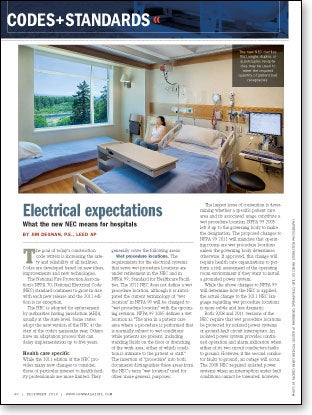Electrical expectations
 The goal of today's construction code writers is increasing the safety and reliability of all facilities. Codes are developed based on new ideas, improvements and new technologies.
The goal of today's construction code writers is increasing the safety and reliability of all facilities. Codes are developed based on new ideas, improvements and new technologies.
The National Fire Protection Association's NFPA 70, National Electrical Code (NEC) standard continues to grow in size with each new release and the 2011 edition is no exception.
The NEC is adopted for enforcement by authorities having jurisdiction (AHJs), usually at the state level. Some states adopt the new version of the NEC at the start of the code's namesake year. Others have an adaptation process that can delay implementation up to five years.
Health care specific
While the 2011 edition of the NEC provides many new changes to consider, those of particular interest to health facility professionals are more limited. They generally cover the following areas:
Wet procedure locations. The requirements for the electrical systems that serve wet procedure locations are under refinement in the NEC and in NFPA 99, Standard for Healthcare Facilities. The 2011 NEC does not define a wet procedure location, although it is anticipated the current terminology of "wet location" in NFPA 99 will be changed to "wet procedure location" with the upcoming revision. NFPA 99 2005 defines a wet location as "The area in a patient care area where a procedure is performed that is normally subject to wet conditions while patients are present, including standing fluids on the floor or drenching of the work area, either of which condition is intimate to the patient or staff." The insertion of "procedure" into both documents distinguishes these areas from the NEC's term "wet location" used for other, more general, purposes.
The largest issue of contention is determining whether a specific patient care area and its associated usage constitute a wet procedure location. NFPA 99 2005 left it up to the governing body to make the designation. The proposed changes to NFPA 99 2011 will mandate that operating rooms are wet procedure locations unless the governing body determines otherwise. If approved, this change will require health care organizations to perform a risk assessment of the operating room environment if they want to install a grounded power system.
While the above changes to NFPA 99 will determine how the NEC is applied, the actual change to the 2011 NEC language regarding wet procedure locations is more subtle and less dramatic.
Both 2008 and 2011 versions of the NEC require that wet procedure locations be protected by isolated power systems or ground-fault circuit interrupters. An isolated power system provides continued operation and alarm indication when either of its two circuit conductors faults to ground. However, if the second conductor faults to ground, an outage will occur. The 2008 NEC required isolated power systems when an interruption under fault conditions cannot be tolerated; however, this language did not acknowledge that an outage will occur if the fault extends to a second conductor. New language is added to the 2011 NEC to clarify that isolated power systems are required in wet procedure locations when a first-fault outage cannot be tolerated, replacing more general language regarding tolerance of interruption of power under fault conditions. Also, isolated power systems now must be placed in dedicated raceways and not mixed with other power systems.
Battery-powered lighting units. In Article 517, the term "emergency" was removed from the middle of the phrase "battery powered lighting units" to clarify that they can be connected to critical branch lighting circuits in anesthetizing locations. These units also are used in operating rooms to sustain some light during the time between a power failure and when the emergency generator comes online.
Receptacle outlet box ground wires. The code language was rearranged to make it clear that receptacle outlet boxes must be bonded directly to the branch-circuit equipment grounding conductor, and not merely rely on the receptacle mounting strap.
Isolated ground receptacles. Previously, isolated ground receptacles were permitted in health care facilities if they were visibly identified. As of 2011, they will no longer be permitted. The prohibition follows a general industrywide trend toward not utilizing isolated grounding receptacles to serve information technology equipment.
Available fault current. Service switchboards now must bear a label indicating the actual fault current available at their terminals. This information must come from the utility company that supplies the main service switchboard.
Switchboard manufacturers always have identified the fault current ratings for which their equipment was constructed, but this did not convey information that might be necessary for additional analysis, such as determination of arc-flash hazards. The arc-flash hazard determines the level of personal protective equipment that must be utilized if an electrician works on an energized system, which is often the case in health care.
Ground fault protection systems. Ground fault protection is special sensing that detects low levels of fault current that a regular overcurrent protective device, such as a fuse or circuit breaker, might not catch. For many years, the NEC has required ground fault protection of services and feeders rated over 1,000 amps. Hospitals were required to have two levels of ground fault protection between the utility service and the transfer switch; however, the portion of the system between the generator and the transfer switch was exempt from the ground fault protection requirement.
The 2011 NEC removes the exempting requirements for ground fault protection between the generator and the transfer switch. Proponents of this change note that many generating systems pose the same hazards as large utility systems and that adding ground fault protection will improve reliability by helping to isolate a fault. Also, the selective coordination requirement for six cycles of separation between the two levels of ground fault current tripping bands was removed. A six-cycle separation was excessive. The new language requires conformance with the ground fault sensor manufacturer's recommendations, results in no loss of reliability, and improves the flexibility of system design.
Multiwire branch circuits. The use of multiwire circuits for receptacles supporting patient beds now is prohibited by NEC Sections 517.17 and 517.18. A basic electrical circuit requires two wires to connect to a load; however, if the source transformer is configured with a neutral conductor, multiple load circuits can share the neutral. For example, a three-phase 120/208-volt transformer with a neutral can serve three 120-volt loads using four wires instead of six. Utilizing a shared neutral approach requires electricians working live circuits to be cognizant of possible backfeed, which could result in electrocution. In the 2008 NEC, this safety hazard was eliminated by requiring a common disconnect for all circuits sharing a neutral conductor. In the previous example, a common disconnect means an owner would have to de-energize three circuits to work on any one circuit. Recognizing that a common disconnect could severely compromise patient care by de-energizing several receptacles or patient beds, multiwire circuits no longer can be used for beds. The resultant code will increase the patient bed branch-circuit wiring cost by 50 percent.
Patient bed receptacle types. The new code clarifies that single, duplex or quad-duplex receptacles may be used to meet the required quantity of patient bed receptacles. As an aside, the upcoming version of NFPA 99 likely will increase the minimum required quantity of patient bed receptacles.
Fire pump and high-rise feeder fire ratings. Fire withstand ratings were increased in the 2011 NEC from 90 minutes to 2 hours as it applies to fire pump and emergency circuits. The longer rating makes the NEC consistent with other NFPA building codes.
Essential electrical system distribution. New language added to the 2005 and 2008 versions of the NEC occasionally was being interpreted by local AHJs to require all feeders to automatic transfer switches to originate at the generator or the generator paralleling switchboard. The permissive language added to NEC section 700.10(B)(5)(d) allows single or multiple feeders to extend from the generator up to the point where the feeders are separated. This language makes it clear that it is acceptable to run a feeder from a central energy plant to another building, and then separate the essential electrical system feeder into appropriate branches within the building.
Communication wiring. NEC Article 800 has extensive additions clarifying appropriate wire types for use in plenums, HVAC ducts and risers. The new code distinguishes applications of cable types.
Solar requirements. Photovoltaic conductors now must identify source, input and output as well as distinguish between multiple systems. Direct current (DC) source and output circuits now require circuit protection utilizing listed DC arc-fault circuit interrupters. The arc-fault circuit interrupters are more sensitive and can detect short circuits that conventional fused and circuit breakers will not sense.
Requirements for grounding of photovoltaic sources and mounting structures also are clarified.
Check with the state
Health facility professionals should check with their state AHJs to determine which codes they must follow. For more on the NEC as well as proposed changes to NFPA 99, Standard for Healthcare Facilities, go to www.NFPA.org.
Jim Degnan, P.E., LEED AP, is principal and chief engineer at Sparling, a Seattle-based electrical and technology consulting firm that specializes in health care planning and design. He can be reached at jdegnan@sparling.com.




